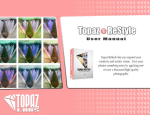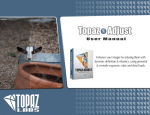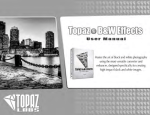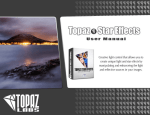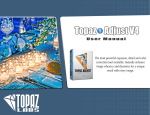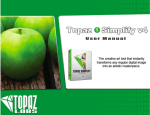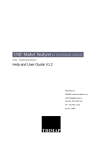Download Users Guide - Topaz Labs
Transcript
Topaz ReMask User Guide The quickest and easiest way to create professional extractions and masks. Contents Topaz ReMask User Manual I. Installation A. System Requirements . . . . . . . . . . . . . . . . . . . . 3 B. Download Instructions. . . . . . . . . . . . . . . . . . . . 3 C. Installation . . . . . . . . . . . . . . . . . . . . . . . . . . . . . . 3 D. Compatibility . . . . . . . . . . . . . . . . . . . . . . . . . . . . 3 E. Accessing ReMask in Host Programs . . . . . . 4 F. Uninstalling. . . . . . . . . . . . . . . . . . . . . . . . . . . . . . 5 G. Entering License Key . . . . . . . . . . . . . . . . . . . . . 5 II. Introduction A. Masking Unveiled. . . . . . . . . . . . . . . . . . . . . . . 6 1. What is Masking? . . . . . . . . . . . . . . . . . . 6 2. Benefits of Masking. . . . . . . . . . . . . . . . 6 3. When is Masking Needed?. . . . . . . . . . 6 4. Why Use ReMask 5. . . . . . . . . . . . . . . . . 6 5. How Does ReMask 5 Work?. . . . . . . . . 6 B. Topaz ReMask . . . . . . . . . . . . . . . . . . . . . . . . . . . 7 1. About Topaz ReMask. . . . . . . . . . . . . . . . 7 2. Primary Functions of ReMask . . . . . . . . 7 C. New ReMask 5 Features. . . . . . . . . . . . . . . . . . 8 III. Work Area A. Interface Overview. . . . . . . . . . . . . . . . . . . . . . 9 B. View Options . . . . . . . . . . . . . . . . . . . . . . . . . . . 11 C. TriMap Technology. . . . . . . . . . . . . . . . . . . . . . 13 D. Tools. . . . . . . . . . . . . . . . . . . . . . . . . . . . . . . . . . . 14 1. General Tools. . . . . . . . . . . . . . . . . . . . . . 14 2. Brushes. . . . . . . . . . . . . . . . . . . . . . . . . . . 14 3. Fills. . . . . . . . . . . . . . . . . . . . . . . . . . . . . . . 15 4. Adjustments . . . . . . . . . . . . . . . . . . . . . . 15 5. Background Options . . . . . . . . . . . . . . . 17 E. Menu 1. Preferences. . . . . . . . . . . . . . . . . . . . . . . 19 2. Check for Updates. . . . . . . . . . . . . . . . . 19 3. Enter Key . . . . . . . . . . . . . . . . . . . . . . . . 20 4. Set Background Color. . . . . . . . . . . . . 20 5. Save Trimap/Mask . . . . . . . . . . . . . . . . 20 6. Load Trimap/Mask . . . . . . . . . . . . . . . . 20 7. What’s This?. . . . . . . . . . . . . . . . . . . . . . . 21 8. Users Guide. . . . . . . . . . . . . . . . . . . . . . . 21 9. Tutorials . . . . . . . . . . . . . . . . . . . . . . . . . . 21 10. Tech Support. . . . . . . . . . . . . . . . . . . . . . 21 11. Product Info. . . . . . . . . . . . . . . . . . . . . . . 21 12. About . . . . . . . . . . . . . . . . . . . . . . . . . . . . 21 13. Startup Guide . . . . . . . . . . . . . . . . . . . . . 21 IV. Additional Resources A. Glossary. . . . . . . . . . . . . . . . . . . . . . . . . . . . . . . . 22 B. FAQ’s. . . . . . . . . . . . . . . . . . . . . . . . . . . . . . . . . 24 C. Shortcut Keys. . . . . . . . . . . . . . . . . . . . . . . . . . 26 D. Connect. . . . . . . . . . . . . . . . . . . . . . . . . . . . . . . 28 E. Company Info. . . . . . . . . . . . . . . . . . . . . . . . . . 29 2 Installation Topaz ReMask User Manual Topaz ReMask works as both a standalone editor and plugin. This means a compatible host editor is not required to use Topaz ReMask, although you may access it as a plugin in a few compatible host editors. System Requirements Mac OS X 10.8 or higher Windows 7/8 x64 + Open GL 2.1 *Does not support Windows 32bit Download Instructions • To download ReMask please visit topazlabs.com/ downloads. • Locate Topaz ReMask and click on the appropriate Mac or Windows button beneath that product to start your download. • The download should start automatically, however if prompted, select ‘Save’. • The downloaded installer will then be located in your Downloads folder or desktop as an .exe file (Windows) or a .dmg file (Mac). Installation 1. Exit Photoshop or any other image editing program if it is open. 2. Open the Topaz ReMask .dmg or .exe file, doubleclick on the Topaz ReMask installer and then follow the on-screen instructions. 3. After installation is complete, open Photoshop and ReMask will be located in the Filter menu. 4. See our FAQ’s (page 56) for additional support. Please see our knowledge base at topazlabs.com/ support should you need any additional installation assistance not answered in the FAQ’s. Important Note: While the Topaz plug-ins work in a variety of host editors, ReMask is not compatible with Lightroom, Aperture or iPhoto, as it requires layers and transparency to function. Therefore, ReMask will not appear in the external editor Fusion Express. Compatibility ReMask can be accessed as a plugin in: Mac Dmg Windows exe The program will then install as a standalone editor to: Mac: Applications folder Win: C:\Program Files\Topaz Labs\Topaz ReMask • • • • • • • Photoshop CS4+ Photoshop Creative Cloud Photoshop Elements 6+ Corel Paintshop Pro X Serif Photo Plus X5+ Lightroom as an external editor NOT compatible with photoFXlab or Fusion Express 3 Installation Topaz ReMask User Manual Accessing ReMask in Host Programs Important: Your image will need to be 8-bit or 16-bit and in RGB mode. Go to Image-> Mode to change this. Photoshop, PSE, and PSCC Accessing ReMask in Lightroom To use ReMask as a plugin in Ps, Pse and PsCC you must first run it as a standalone editor (Mac only). ReMask will then be available to use in Photoshop via the Filter menu. For Windows, the plugin should automatically appear in the Filter list. I can’t find ReMask in the Photoshop Filter menu After installation is complete, open Lightroom and navigate to Photo -> Edit In -> Topaz ReMask 5. Please Note: Lightroom does not support layers. Any transparent masked areas will be returned to Lightroom as white. Any images with solid color or image backgrounds will be returned to Lightroom as flattened images. Accessing ReMask in Corel Paintshop Pro 1. First launch PaintShop Pro. 2. Go to Menu file -> Preferences -> File Locations. Select “Plug-ins” from the “File Types” list and click “Add”. 3. Choose C: \ Program Files \ Topaz Labs \ Topaz ReMask plug-ins and click “OK”. Should ReMask not appear in the Filter menu, you may need to exit out of Photoshop and then re-open it. 4. Topaz ReMask 5 is now available to use. Simply go to Effects -> Plug-ins and select “Topaz ReMask 5 ”. 4 Topaz ReMask User Manual Uninstalling To uninstall Topaz ReMask follow these instructions: Mac 1. Quit Photoshop (or other editing program). 2. Navigate to Macintosh HD -> Library -> Application Support -> Topaz Labs. *To find this, go to your desktop and click on Go-> Computer (top menu) Installation 4. Select Topaz ReMask and click remove. Windows 7* 1. Quit Photoshop (or other editing program). 2. Click on the Start Menu and select Control Panel -> Programs -> Programs and Features. 3. Select Topaz ReMask and click uninstall. 3. Locate the Topaz ReMask file and move it to the trash. You will need to enter your system password to OK this change. *Please note that if you also have the 64-bit version of ReMask installed, then you will need to first uninstall this version before you can uninstall the regular version. 4. Navigate to your Photoshop plug-ins folder located at: Applications -> Photoshop -> Plug-ins Entering License Key 5. Locate any leftover Topaz ReMask files and move them to the trash. 1. To activate the program, open ReMask and select Menu-> Enter Key (bottom left corner). Windows XP* 1. Quit Photoshop (or other editing program). 2. Enter or copy & paste your 30-digit license key to start your trial or activate the program. (Be sure that you have not copied any extra spaces). 2. Click on the Start Menu and select Control Panel. 3. Double-click on Add / Remove programs. 4. Select Topaz ReMask and click remove. Windows Vista* 1. Quit Photoshop (or other editing program). 2. Click on the Start Menu and select Control Panel. 3. Select Programs, then Uninstall a Program. 3. If you are running trial mode, to switch to the full version all you need to do is enter your full license key. You do not need to uninstall the current software as the only difference between the full and trial version is the key used to activate the program. 5 Topaz ReMask User Manual Introduction Masking Unveiled a new innovative trimap technique. The trimap is made up of three tones: green, red and blue. What is Masking? Users are able to quickly define the elements in their image that they want to keep using green; elements that they want to cut using red; and elements that they want Topaz ReMask 4 to compute using blue. Masking is the process of isolating a subject or specific image elements that you wish to preserve, then erasing everything else that you do not want. It is also referred to as extraction or cutouts. What are the benefits of masking? Masking allows you to take the desired subject and elements & cut them out and then merge them into another image scene or background. Masking makes it easy to change the theme, scene or setting of your digital photography subjects. Selections are made using the brush tools and then Topaz ReMask 4 is able to analyze the user-made selections and isolate the image subject with prec ision. Masking is not just for creating composite images; it also makes it possible to adjust only parts of the image. For example, selectively increasing saturation, contrast, brightness, etc. (also called selective adjustments). 6 When do I need to mask? Masking your digital images is ideal when you want to remove backgrounds and unwanted detail elements or to protect an area of your image from adjustments. Why do I need Topaz ReMask 5? Topaz ReMask 5 features easy to use, intuitive tools that will save you time and money by simplifying the masking process. With Topaz ReMask 4 you can eliminate the busy work of using masks, paths, layer adjustments, selections and eraser tools to isolate a subject in your image. How Does Topaz ReMask 5 Work? Topaz ReMask streamlines the masking process using ReMask TriMap For video tutorials and other helpful resources please visit us at: blog.topazlabs.com/tutorials and youtube.com/topazlabs Topaz ReMask User Manual Topaz ReMask About Topaz ReMask Topaz ReMask is a masking and extraction tool that makes it easy to extract elements from your digital images. Isolating an object from a background is typically a difficult and time-consuming task, however ReMask simplifies the process with its intuitive tools to help you quickly make extractions. ReMask makes merging multiple image elements seamless, giving you ultimate control over creating and refining your image scenes. Introduction Primary Functions of Topaz ReMask: 1. Simplified and lightning-fast masking and extraction. 2. Easily extract highly intricate image details and transparent objects as well. 3. Precise cutting for delicate and complex images like hair, fur and transparent objects (i.e. wedding veils). 4. Preserve edges and other intricate image details. 5. Make a believable composite that smoothly blends multiple images together With Topaz ReMask you can: • Easily extract intricate image details 7 • Quickly isolate areas for selective adjustments • Make unique compositions • Replace backgrounds • Selectively blur only the background for a simulated bokeh effect • Creatively emphasize the subject easily and naturally To connect with other Topaz users, sign up with the Topaz Forum online at: topazlabs.com/forum The color-coded trimap system makes masking easy to understand. It’s as simple as keep, cut, compute! Introduction Topaz ReMask User Manual New ReMask 5 Features Topaz ReMask 5 Features 1. Standalone Program GREAT NEWS! You no longer need a host editing program to use ReMask. Now you can run ReMask 5 as a standalone program or as a plugin. This will also enable ReMask to be used with Lightroom. When installing ReMask 5 the icon will be added to your Applications, along with your other standalone Topaz programs. 2. Background Replacement and Editing We’ve added new features that allow you to replace and edit the background of your masked image without having to leave ReMask. Once you compute your mask a background panel will appear in the editing parameters on the left. you select an image background. The orange transform icon will allow you to scale and rotate the background image. Once you have the background image to the size and position that you want, click the orange icon again to deselect the background image and continue editing. The yellow image select icon will allow you to change background images from the image you originally selected. 8 Beneath the background icons are sliders that will allow you to edit the background image to better match the masked foreground. 3. Removed Background Color Selector Icon With the enhanced background panel and additional background editing options, the tri-circle background color selector icon is no longer necessary. It has been removed to streamline the user interface. You can choose from a transparent, solid color, or image background. Additional options appear after Topaz ReMask User Manual Work Area Interface Overview The Topaz ReMask 5 interface is straightforward, simple and very easy to use. You’ll be a pro after experimenting for a bit. In order to make sense of the program features and the function of the tools, we have divided the interface into five sections: 9 Work Area Topaz ReMask User Manual 3 1 5 4 2 10 1. Preview Navigator 2. Editing Parameters 3. Editing Views 4. Preview Window 5. Split Screen Views Displays the region of the preview image you are currently focused on. Displays all of the tools that you will need to successfully create your mask. Displays editing views used during the masking process. Displays the preview of each editing view. Single, double and quad screen options. Also new option to use checkerboard or color background (Keep and Cut views only). Work Area Topaz ReMask User Manual View Options The large Preview window shows you the processed preview of your image. 11 View Modes ReMask 5 gives you five options for viewing your image in the preview section while creating your mask. Choose from Original, Trimap, Mask, Keep, or Cut modes. View Tabs Within ReMask you also have split screen capabilities which allow you to view multiple modes at the same time. This includes single, double or quadruple view. Work Area User Manual Topaz ReMask Example of quadruple view TriMap Original Mask Keep 12 Work Area Topaz ReMask User Manual TriMap Technology Topaz ReMask uses trimap technology to create your extraction. Using the green, red and blue primary brush tools, you will define the areas that you want to keep (green), remove (red) and compute (blue). 1. Red Area The red area represents the part of the image that you want to remove. 1 2. Blue Area (Outline) The blue area represents the part of the image that you want to compute. Topaz ReMask 5 will analyze this area to help extract the unwanted background from the desired image subject. 13 2 3. Green Area The green area represents the part of the image that you want to keep. 3 Work Area Topaz ReMask User Manual Tools General Tools The general tools include: undo, redo, selection marquee, hand tool, and zoom. The square selection marquee tool allows you to select a certain area of your image to mask without affecting the areas outside of that boundary. BRUSHES Primary Brushes The primary (or basic) brush tools allow you to select the elements in the image t hat you want to keep (green), remove (red) and compute (blue). The primary brushes will turn into the Topaz Magic brush after you select Compute. Brush sizes range from 1 - 255. 14 To pan the preview image, select the hand tool (press H ) and hold the left mouse button on the preview image and drag it around. You can also pan your preview image by holding the spacebar key and moving your mouse or by using the red selection box in your preview navigator. Topaz Magic Brush The Topaz Magic Brush tool (which becomes available after you select “Compute Mask”) allows you to make intricate detail eliminations and recoveries to selected parts of your image. It will only affect the blue area of your initial trimap. It will not change your original red and green selections. Topaz ReMask User Manual Color Range Brushes These brushes allow you to brush out the foreground or background area in your image, based on the color selected and the setting of the Color slider. Color Range The Color Range slider allows you to determine the spectrum of shades affected within the image based on the main color selection. Work Area Transparency Brushes This brush allows you to define two colors (keep/ green and remove/red) to target at once. The transparency brush is key for images where transparency is a factor because it will allow users to select a foreground color, such as the white of a wedding veil, and a background color to be removed from behind the veil. Foreground Color Background Color FILLS The fill tools allow you to fill all of your image or just a portion of your image with the selected color. Compute Mask The Compute Mask button will analyze your trimap selections and create your image mask. After you click this button additional mask refinement tools will appear allowing you to create a more accurate mask. 15 User Manual Topaz ReMask ADJUSTMENTS After you make your trimap selections you will need to click on “Compute Mask” for your selections to be analyzed and your mask created. Once your mask is created the Adjustment options will appear, allowing you to refine your mask even further. Work Area Edge Hardness Determines how hard your mask is applied to subject edges in your image. The higher the parameter the harder your edges will be. The lower the parameter, the softer (more feathered) your edges will be. Mask Strength Determines the brightness of the mask. Increasing this parameter will give you more detail by making the weaker mask details stronger. Edge Shift Shifts the mask edge by one pixel in either direction. Recovery (Foreground Color) Revives the color of your foreground in weaker / more transparent areas. Desaturation (Foreground Color) Desaturates the edges of your mask (in weaker/more transparent areas) to help with color contamination and bleeding. Reset The reset tools allow you to reset your entire image to the selected trimap color. Using this feature will erase any previous selections made. 16 User Manual Topaz ReMask BACKGROUND Once your mask is refined you have the ability to select which type of background you would like for your image: transparent, solid color, or image. You also have the ability to make some adjustments to the background, if you choose an image background. Work Area Transform The transform icon will allow you to make changes to the scale and orientation of your background image. Image Select The image select icon will allow you to change your background image to a different image. 17 Transparent Selecting a transparent background will hide everything that you selected to Cut in your mask and will appear on screen as a gray and white checkerboard pattern. Solid Color The solid color background option allows you to choose what color will appear in place of Cut selections. This is an excellent way to check your mask as well. Image Selecting this option will open your computer file browser, allowing you to select an image as the background. Brightness Adjusts the brightness of your image. Drag to the left to decrease brightness. Drag to the right to increase brightness. Contrast Adjusts the difference between light and dark colors in your image. Drag to the left to to increase contrast difference. Drag to the right to decrease contrast difference. Saturation Adjusts the depth of color in an image. Drag to the left to decrease depth and brightness, moving closer to a monochromatic image. Drag to the right to brighten and deepen colors. Topaz ReMask User Manual Temperature Adjusts how cool or warm an image is. Drag to the left to create a colder (blue) image. Drag to the right to create a warmer (yellow) image. Tint Adjusts the color tones of your image. Drag to the left to give your image a green tint. Drag to the right to give your image a magenta tint. Blur Adjusts how clearly you see the background image. Drag to the right to increase the amount of blur on the background image. Saving Your Image Saving your image with ReMask is a fairly simple task. To save navigate to the bottom right corner and select ‘Save As’ Another way to save your image is to navigate to the top menu bar and select File-> Save As 18 You’ll then have the option to name the file and choose the file types: JPEG, TIFF and PNG Subject masked out and background blurred using ReMask 5 as a standalone program. Depending on the file type, you’ll then be presented with several options including color space and bit depth. Topaz ReMask User Manual Menu You can access the Topaz ReMask menu by clicking on the “Menu…” button at the bottom left area of the interface. Work Area Enable Brush on Original Image Allows you to draw on the original image (you will not see anything changed on the original image). When this option is turned OFF, drawing on the original image will force switch the view to Trimap view. Enable Sticky Mode for f/b brushes Allows you to enable the sticky mode for your foreground/background (f/b) brushes. Enable Zoom with Mouse Wheel (Mac users only) Allows user to zoom in using their mouse. May be turned off for Mac users with Apple Magic Mouse. Enable Auto-Create Layer Automatically creates a new image layer for you in Photoshop. Preferences Select this to enable or disable the program tool tips or the Auto-Update feature. Enable Use Layer Mask Automatically saves your ReMask extraction back to a layer mask. Enable Tooltips Allows you to enable or disable the pop up tips during your workflow Enable Auto-Update Allows ReMask to automatically check for and download available Topaz ReMask updates. Check for Updates Checks for available Topaz ReMask updates. 19 Topaz ReMask User Manual Enter Key Select this to enter your trial or purchased license key. Work Area Save Trimap/Mask Select this feature to save your trimap/mask currently in progress in order to resume editing at a later time. The file will be saved as a tiff. You can name the file and save it to any safe location on your computer. Your saved trimap/mask will appear in this format: Set Background Color Use the Set Background Color option to change the background color on your mask using several different color palette options for better mask visibility. 20 Load Trimap/Mask Select this feature to load a previously saved trimap/ mask to continue editing on. You must have the original image that pairs up with the selected mask in order to load it or else you will receive this message: Topaz ReMask User Manual Work Area What’s This? Select this (or click F1) then click on a feature in the ReMask interface to learn more about it. Users Guide Select for quick access to this user guide. Tutorials Takes you to the Topaz ReMask tutorials page where you can access additional written and video tutorials to help you with your ReMask workflow. Tech Support Brings you to the Topaz Labs support page where you can request assistance from our support specialists, contact our customer service team, retrieve lost license keys, or browse through our Knowledge Base. Before ReMask: The image is saturated and the brick wall in the foreground takes focus away from the couple. Product Info Select this to go to the Topaz ReMask web page to learn more about the Topaz ReMask plug-in. About Select this to see what version of ReMask you currently have. Startup Guide Shows a step-by-step quick overview on how to use ReMask. This is the pop-up that shows when you first open the program and can be disabled. After ReMask: The couple was masked out, allowing for separate selective adjustments to their saturation and the new monochromatic background. Now they are the focus! 21 Topaz ReMask User Manual 50% Gray – The undefined area that the computer (Topaz ReMask) will need to figure out. Achromatic - Without color. Action – A recorded task that works as an automated memory of the enhancement and adjustment steps executed on an image. Once an Action has been recorded it can be invoked and reapplied to other images without manually making the changes. Adjustment Layer – A layer that allows you to adjust the look of an original image with out making it permanent. With adjustment layers you can make various changes to a layer without damaging it and go back and readjust it at anytime. Algorithm – Any bit of code or programming that defines a process. Alpha Channel – Photoshop alpha channels are masks through which you can apply effects. The alpha channel is an 8-bit channel, which means it has 256 levels of gray from 0 (black) to 255 (white). An alpha channel lets you save and load selections. Black Area - The masked area, which indicates the portion of the image that you wish to get rid of. Blue Area - The undefined area that the computer (Topaz Mask) will need to figure out. Chroma - Purity or intensity of color. CMYK – Cyan, magenta, yellow, and black. A color model commonly used for 4-color printing by printers to define and mix all of the colors they are capable of outputting. Glossary Color Bleed (Color Contamination) - the transfer of color between nearby objects, caused by the colored reflection of indirect light. Color Decontamination - reduces color cast on the edges of a selection. Color Channel – The visual component of a color digital image that represents all the pixels in that picture made up of a specific primary color. For example, in a typical digital photo, the primary colors of red, green and blue (from the RGB color model) create all the colors in that photo, which may be represented by three color channels, each of red, green or blue. Desaturate - Decreasing the intensity of a color (hue). Diameter (brush) - Controls the size of the brush. Download – The process of transmitting or transferring data from one device to another. Export – Outbound data transfer in a format that can be used by other programs. Filter Adjustment – Allows you to shift the overall color in an image. Green Area (Trimap View) - The active area, which indicates the portion of the image that you wish to keep. Gradient - The gradient tool creates a gradual blend between multiple colors. Hardness (brush) - Controls the size of the brush’s hard center. 22 User Manual Topaz ReMask Import – Inbound data transfer into a file or document. Layer Mask – An editable selection, attached to a layer that tells Photoshop how to deal with the layer that it is attached to. It enables us to get rid of a part of the layer but with the possibility to go back and edit the result at any time (also called nondestructive editing). It in fact blocks part of the layer from appearing, as if erased, while still being there. Layer Masks provide extra flexibility to your Photoshop layers. Quick Mask - Allows you to paint on your selection (or the masked area). Then once you have your selection, you can delete it, recolor it, mask it, etc. Red Area - The masked area, which indicates the portion of the image that you wish to get rid of. Refine – Improve (something) by making small changes to make it more subtle and accurate. Non-Destructive Editing - A form of editing where the original content is not modified in the course of editing - instead the edits themselves are edited. This allows for easy adjustments and images effects at a later time making photo editing quick and flexible. RGB – Red, Green, Blue. The color model that is used in digital cameras and by computer monitors. Opacity – The amount of transparency a layer has. Trimap – User-generated mask map with three tones. In Mask View: White (keep) , Black (remove) and Gray (compute) In Trimap View: Green (keep), Red (remove) and Blue (compute) Pan and Zoom - A useful function that allows users to magnify the captured image in the preview and then, by using the cursor, to move or pan around the image. Typically Pan and Zoom allows users to magnify the image 2x or 4x time. By magnifying the images and zeroing in on a specific section, you can see details not visible when the entire image is sized to fit the preview. Photo-editing or Imaging software – Programs in which you can alter your photos and / or create digital images. Depending on the software, you can improve exposure, color and other attributes of your picture, paint on it, add type, apply special effects, remove noise, resize it, combine it with other pictures, prepare it for email or posting on the web, output it to a printer or do any number of other manipulations or edits. Plug-in - Computing (of a module or software) able to be added to a system to give extra features or functions. Saturate - Increasing the intensity of a color (hue). Transparency - in reference to a portion of an image that is completely invisible (as it has been removed). White Area (Mask View) - The active area, which indicates the portion of the image that you wish to keep. 23 FAQ’s Topaz ReMask User Manual I need a Topaz ReMask 5 trial key. Visit www.topazlabs.com/checkout for a trial key. If you need more time to evaluate, please contact us at: http://www.topazlabs.com/support for an extended trial key. I can’t find Topaz ReMask 5 in the Photoshop Filters menu. For Windows: 1. Please go to your preferences menu in Photoshop and select Plug-ins. 2. Check/enable the Additional Plug-ins Folder option then click Choose. 3. After that, please navigate to: C: \ Program Files and select the Topaz Labs folder. 4. Then click Choose (or it may say Save/OK) to save this back to Photoshop. 5. Click OK to save your changes, then restart Photoshop. Once Photoshop opens, go to your Filter menu and you should be able to access Topaz. For Mac: 1. Please go to your preferences menu in Photoshop and select Plug-ins. 2. Check/enable the Additional Plug-ins Folder option then click Choose. 3. After that, please navigate to: Computer -> Macintosh HD -> Library -> Application Support and select the Topaz Labs folder. 4. Then click Choose (or it may say Save/OK) to save this back to Photoshop. 5. Click OK to save your changes, then restart Photoshop. Once Photoshop opens, go to your Filter menu and you should be able to access Topaz. If I use the 30-day trial version will I need to uninstall the trial version before I upgrade to a full version? No, there is no difference between the trial and full version, except for the license key used to activate the program. To take yourself off trial mode, simply enter your full license key under Menu-> Enter Key. Do you have any other ReMask tutorials? Yes, we have plenty of tutorial videos on our YouTube channel at youtube.com/topazlabs. Also be sure to check out our tutorials page at blog.topazlabs.com/ tutorials When I fill my red (cut) areas on my trimap the whole image filled with red. There is most likely a gap somewhere in blue (compute) outline. The blue outline acts like a barrier in order to ensure accurate masking results. Use your undo button to go back a step then zoom in and pan your image to find the opening in your blue outline. Once you locate it, select your blue brush tool and close it off. Then you can select your red flood fill tool and fill in the parts of your image that you would like to cut. I get the error: ‘You have not selected Compute Mask to compute your selections. Please click OK to go back and select Refine Mask. To exit without making changes to your image please select cancel.’ This is because your trimap selections have not been analyzed. You will need to click on the Compute button in order to create your mask. After that you can select OK and process your entire image. Why doesn’t ReMask appear in Lightroom/iPhoto/ Aperture/Fusion Express? 24 Topaz ReMask User Manual Topaz ReMask is not compatible with these specific programs, as it requires a host editor that supports layers and transparency. If you do not own a host editor that supports layers (e.g. Photoshop, PaintShop Pro), we offer a standalone editor, PhotoFXlab, that will allow you to use ReMask and can be accessed as an external editor in Lr, iPhoto & Aperture. How do I place my masked subject on a new background? Once you have extracted your subject and are back to your host editor, open up the background you wish to place the object on. Go back to your masked image and make sure the masked layer is selected in the layers panel and then press cmd/ctrl + A to select, and cmd/ ctrl + C to copy that selection. Now switch back to your background and press ctrl/cmd + V to paste that selection. To resize, press ctrl/cmd + T and hold down the Shift key to maintain proportions. FAQ’s How many computers may I install the software on? You may install the purchased software on up to two computers at a time. Simply download the software from our downloads page to put it on another computer and use the same license key to activate it. I have a question not listed here. If you are not able to find the answer here then please visit our knowledge base where you can also submit a support ticket for additional assistance: www. topazlabs.com/support 25 Can I save my trimap for future use? Yes, simply go to Menu-> Save TriMap/Mask. When you want to re-load it, go to Menu-> Load TriMap/Mask Are upgrades free? How do I upgrade my software? Yes, with Topaz Labs upgrades for exisiting purchased products are complimentary. To upgrade, all you need to do is download the updated software from our downloads page at topazlabs.com/downloads and your license key will work with the upgraded version. If using PhotoFXlab or Fusion Express, you’ll need to update those programs as well from our downloads page. Please make sure that you are exited out of all host editors before installing the software. Masking objects and changing the background can help change the mood of your image. ReMask can make easy work of intricate objects with many small spaces, like trees and wedding veils. Shortcut Keys Topaz ReMask User Manual Topaz ReMask 5 uses some shortcut keys to speed up your workflow. Many of these keys are similar to those in Photoshop. The following keys work at all times. Action Shortcut Undo Redo Primary Keep Brush (Green) Marquee Tool Hand Tool Remove Marquee Primary Cut Brush (Red) Zoom In Zoom Out Zoom to Fit Zoom to 100% Primary Compute Brush (Blue) Color Range Brush (Green) Color Range Brush (Red) Transparency Brush Green Fill Red Bill Blue Fill Increase Brush Size Decrease Brush Size Compute Mask for TriMap Transform Background Tool Deselect Transform Background Ctrl (Cmd on Mac) + Z Ctrl (Cmd on Mac) + Shift + Z Q M H or spacebar Ctrl (Cmd on Mac) + D W + Ctrl (Cmd on Mac) + 0 (zero) Ctrl (Cmd on Mac)+ Alt + 0 E A S Z R T Y ] [ Enter Ctrl (Cmd on Mac) + T Double click 26 Shortcut Keys Topaz ReMask User Manual Action Shortcut Menu Set Background Color Save TriMap/Mask Load TriMap/Mask View Original Image View TriMap View Mask View Keep View Cut Single Screen View Double Screen View Quad Screen View Process Whole Image (OK) Draw Straight Lines Open Image Save Image Exit ReMask O Ctrl (Cmd on Mac) + B Ctrl (Cmd on Mac) + M Ctrl (Cmd on Mac) + L 1 2 3 4 5 8 9 0 (zero) Ctrl (Cmd on Mac) + Enter Shift + left mouse click Ctrl (Cmd on Mac) + O Ctrl (Cmd on Mac) + S Ctrl (Cmd on Mac) + Q 27 Topaz ReMask User Manual Connect Connect with Topaz Follow us on Twitter (@topazlabs) for notifications of recent news and easily get in touch with us whenever you feel like it! Find us on our Facebook page and network with other Topaz users! Participate in the entirely user-led Topaz Flickr group for a helpful and highly active community for Topaz Photoshop plug-ins! Subscribe to our YouTube channel to keep up with any newly released product video tutorials! Check out our blog for tutorials, tips and updates from Topaz Labs! And don’t forget to check out our other social media outlets including: Instagram (@topazlabs), Pinterest, LinkedIn and Google+! 28 Contact Topaz ReMask User Manual Contact Information Topaz Labs, LLC 14285 Midway Road Suite 125 Addison, TX 75001 Technical Support Visit: topazlabs.com/support Email: [email protected] 29 Topaz Labs LLC, a privately owned company headquartered in Dallas, Texas, focuses on developing advanced image enhancement technology. With today’s widespread use of digital still cameras, the need for high-quality digital images has greatly increased. Topaz Labs’ mission is to bring practical state-of-the-art image enhancement technology to both professionals and consumers. Copyright © 2015 Topaz Labs, LLC. All rights reserved. www.topazlabs.com






























